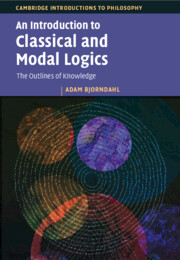Refine search
Actions for selected content:
83 results
Chapter 2 - The Predecessors’ Dilemma
-
- Book:
- Aristotle on the Nature and Causes of Perception
- Published online:
- 01 May 2025
- Print publication:
- 22 May 2025, pp 44-71
-
- Chapter
-
- You have access
- Open access
- HTML
- Export citation
Chapter 3 - Complete Passive Activity
-
- Book:
- Aristotle on the Nature and Causes of Perception
- Published online:
- 01 May 2025
- Print publication:
- 22 May 2025, pp 72-99
-
- Chapter
-
- You have access
- Open access
- HTML
- Export citation
8 - Broader Applications of Polyhedral Graphic Statics
-
-
- Book:
- Polyhedral Graphical Statics
- Published online:
- 13 March 2025
- Print publication:
- 20 March 2025, pp 445-530
-
- Chapter
- Export citation

An Introduction to Classical and Modal Logics
- The Outlines of Knowledge
-
- Published online:
- 08 February 2025
- Print publication:
- 21 November 2024
-
- Textbook
- Export citation
Chapter 3 - Militant Neoclassicism
- from Part I
-
- Book:
- Modernism, Aesthetics and Anthropology
- Published online:
- 09 January 2025
- Print publication:
- 23 January 2025, pp 82-124
-
- Chapter
- Export citation
4 - The Rationality of Choice
- from Part I - Trade-Offs and Rationality
-
- Book:
- Economics without Preferences
- Published online:
- 02 January 2025
- Print publication:
- 16 January 2025, pp 59-85
-
- Chapter
- Export citation
A Procedure for Assessing the Completeness of the Q-Matrices of Cognitively Diagnostic Tests
-
- Journal:
- Psychometrika / Volume 82 / Issue 1 / March 2017
- Published online by Cambridge University Press:
- 01 January 2025, pp. 112-132
-
- Article
- Export citation
14 - Is a Deterministic Completion of Quantum Mechanics Possible?
-
- Book:
- The Einstein Paradox
- Published online:
- 14 November 2024
- Print publication:
- 28 November 2024, pp 223-234
-
- Chapter
- Export citation
3 - Schrödinger on EPR
-
- Book:
- The Einstein Paradox
- Published online:
- 14 November 2024
- Print publication:
- 28 November 2024, pp 52-94
-
- Chapter
- Export citation
16 - Can Quantum-Mechanical Description of Physical Reality be Considered Complete?
-
- Book:
- The Einstein Paradox
- Published online:
- 14 November 2024
- Print publication:
- 28 November 2024, pp 244-254
-
- Chapter
- Export citation
18 - States and Reality of Physical Systems
-
- Book:
- The Einstein Paradox
- Published online:
- 14 November 2024
- Print publication:
- 28 November 2024, pp 260-261
-
- Chapter
- Export citation
19 - Quantum Mechanics as a Physical Theory
-
- Book:
- The Einstein Paradox
- Published online:
- 14 November 2024
- Print publication:
- 28 November 2024, pp 262-264
-
- Chapter
- Export citation
26 - Correspondence on the ‘Einstein Paradox’
-
- Book:
- The Einstein Paradox
- Published online:
- 14 November 2024
- Print publication:
- 28 November 2024, pp 281-350
-
- Chapter
- Export citation
4 - Heisenberg on EPR
-
- Book:
- The Einstein Paradox
- Published online:
- 14 November 2024
- Print publication:
- 28 November 2024, pp 95-117
-
- Chapter
- Export citation
21 - Quantum Mechanics and Physical Reality
-
- Book:
- The Einstein Paradox
- Published online:
- 14 November 2024
- Print publication:
- 28 November 2024, pp 266-267
-
- Chapter
- Export citation
12 - Note on the Quantum-Mechanical Theory of Measurement
-
- Book:
- The Einstein Paradox
- Published online:
- 14 November 2024
- Print publication:
- 28 November 2024, pp 208-219
-
- Chapter
- Export citation
2 - Others on EPR
-
- Book:
- The Einstein Paradox
- Published online:
- 14 November 2024
- Print publication:
- 28 November 2024, pp 36-51
-
- Chapter
- Export citation
15 - The Natural-Philosophical Foundations of Quantum Mechanics (Excerpt)
-
- Book:
- The Einstein Paradox
- Published online:
- 14 November 2024
- Print publication:
- 28 November 2024, pp 235-243
-
- Chapter
- Export citation
9 - Can Quantum-Mechanical Description of Physical Reality be Considered Complete?
-
- Book:
- The Einstein Paradox
- Published online:
- 14 November 2024
- Print publication:
- 28 November 2024, pp 157-163
-
- Chapter
- Export citation
1 - Einstein on EPR
-
- Book:
- The Einstein Paradox
- Published online:
- 14 November 2024
- Print publication:
- 28 November 2024, pp 3-35
-
- Chapter
- Export citation
